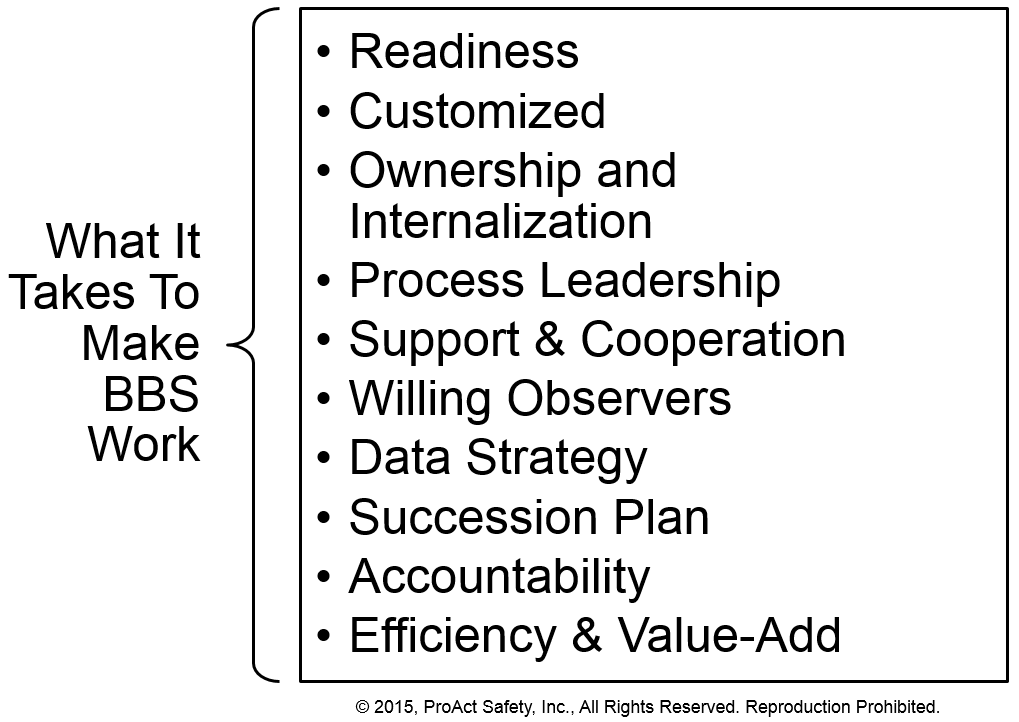Occupational Health & Safety - September 2015
By: Shawn M. Galloway
Printable Version
People tend to respond one of three ways when it comes to Behavior-Based Safety (BBS). There are those who are strong supporters because they have witnessed transformations. Others adamantly despise the process, usually because they either do not understand the intention of the efforts or have had bad experiences due to improper or unethical implementation practices or design choices. Then, there are some who are new to the methodologies and are trying to determine if it is right for them and their organization.
After thousands of BBS-related engagements, the following ten factors to support success have been identified, should be understood, and should be a part of implementation or improvement design choices.
- Readiness - False starts almost always create barriers to future attempts. If the site or culture isn't ready for BBS, it will easily fail; and, if early wins are experienced, they are rarely sustainable. BBS works best when implemented as an addition to traditional approaches (compliance and conditional) to safety. Further, it works because of the existing culture. If the site isn't doing the safety basics, BBS is not a replacement. Make sure to get the culture receptive before you begin.
- Customized - Make the process fit the site and culture; do not make the culture and site fit the methodology. Every organization is different; what people support and don't support will vary site by site. Do not fall in love with a methodology. There are enough programs-of-the-month and, if it is not designed to fit the realities of the organization, it will fail to produce long-term changes and will, instead, become something once attempted back when.
- Ownership and Internalization- For the same reason few people wash rental cars, people prefer to support something they have ownership in. This should not be a consultant's (internal or external) process, checklist, observation strategy, etc. Involve people in the decisions and allow them to provide creative input. This helps facilitate internalization. No team should be held hostage to training materials or checklists that can't be changed. Any process that produces results creates a new cultural reality. If the process isn't updated, it will become an awkward fit.
- Process Leadership - A group of individuals that represent the site (size and participation varies by site) must design the process and meet regularly to review the data, develop and monitor action plans based on the data, and ensure value is being created to the customers of the efforts.
- Support & Cooperation - Leaders at all levels must behaviorally demonstrate support and cooperation. There are typically three types of leaders regarding process support: Leaders who actively demonstrate, leaders that might behave in a way that indicates lack of support, and leaders who don't say anything at all. Ensure a plan is in place to align and monitor support and cooperation with the design and expectations of the process. For sites with bargaining representation, ensure the elected leaders are involved from the beginning.
- Willing Observers - If someone doesn't want to participate and is forced to, what will an employee think when they are being observed by this person, and how will it affect their opinion about BBS? While it is desired for all employees at all levels to eventually be involved, perceptions about trust and the use of the data will initially determine who is an observer. Moreover, not everyone has to be an observer at the same time. Rotation and the use of reserve observers are always an opportunity; just don't force it. BBS is a tool of influence, not a force-change methodology.
- Data Strategy - Processes that don't use the data will, without exception, fizzle out or become a forced effort. There must be a strategy in place that considers how data is collected, analyzed and leveraged for process and safety-specific improvement by reducing the influencers on behavioral choices.
- Succession Plan - When is the worst time to begin interviewing for an open position? When the position is open. This is succession planning 101. Ensure a plan is in place for team members, observers and even the supporting levels of leadership. No group of BBS members or site managers stays in place forever.
- Accountability - Real accountability is ensuring people are doing what is necessary prior to checking on the results. Ensure accountability is focused more on the behaviors to be a team member, observer, supervisor, etc. Also, ensure positive feedback is used just as much, if not more, than corrective feedback.
- Efficiency & Value-Add - Two questions that should continuously be asked and answered are: "Are we as efficient as we could be with our efforts (e.g., blanket vs. focused approaches in observations and checklists)?" and, "Are we delivering (at least the perception of) real value to the customers of our efforts?" If customers do not see visual progress and are not able to point out two or three specific areas where they have benefited from BBS, the process might be viewed as ineffective. Who wants to be a part of a losing team?

Consider these ten factors and how they can be leveraged to improve existing processes. Rarely is it too late to start over. If you are currently looking for options, whatever methodology is chosen, ensure these factors are fundamental in your design choices.
 Shawn M. Galloway is the CEO of ProAct Safety and co-author of several bestselling books. As an award-winning consultant, adviser, leadership coach and keynote speaker, he has helped hundreds of organizations within every major industry to improve safety strategy, culture, leadership and engagement. He is also the host of the highly acclaimed weekly podcast series Safety Culture Excellence®.
Shawn M. Galloway is the CEO of ProAct Safety and co-author of several bestselling books. As an award-winning consultant, adviser, leadership coach and keynote speaker, he has helped hundreds of organizations within every major industry to improve safety strategy, culture, leadership and engagement. He is also the host of the highly acclaimed weekly podcast series Safety Culture Excellence®.
For more information, call (936) 273-8700 or email info@ProActSafety.com.
